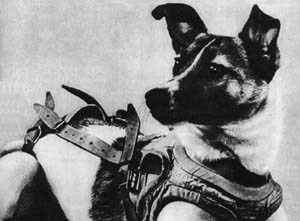There was little known in the 1950s about the effects of gravity in space. To research that, early rocket scientists used animals, particularly monkeys, chimps, and dogs, to ride spacecraft into space to determine how weightlessness affects a living being.1 Soviet canine recruiters began looking for female stray dogs for these experiments, because females were more capable of living in close confinement due to their smaller size, and female dogs were also more docile. To determine finalists for space missions, Soviet scientists placed their canines in small, pressurized capsules for days and weeks at a time, and taught them to eat a nutritious gel that would be provided to them during their space missions. If adapting well to the tests, doctors would monitor the finalists’ reactions to changes in air pressure and loud noises that would be associated with liftoff through a series of surgical procedures.2
In the heat of the Space Race against the United States, Soviet Premier Nikita Khrushchev announced a satellite to be launched to commemorate the 40th anniversary of Russia’s Bolshevik Revolution on November 7, 1957. Soviet rocket engineers went straight to work following Khrushchev’s announcement. Using what they learned from Sputnik I, launched only four weeks prior, Sputnik II included a pressurized compartment for their canine cosmonaut. With the final stage of the rocket attached, Sputnik II’s final weight was 1,120 pounds, and scientists concluded that only one meal for their cosmonaut would be permitted in order to stay within weight limits. However, what the world didn’t know was that Sputnik II was designed to only launch the cosmonaut in orbit without a means of returning, due to the rapidly approaching deadline set by Khrushchev.3

While she wasn’t the first animal to be sent to space, she was the first living being to orbit the Earth.4 Originally named Kudryavka, or Little Curly in Russian, Laika was introduced to the Soviet public via radio, where she barked and gained her better-known nickname Laika, meaning “barker” in Russian.5 Laika was a two-year-old, mixed Siberian husky stray found on the streets of Moscow. Soviet scientists sought after strays like Laika because they assumed that stray dogs already had the experience of enduring harsh conditions of cold temperatures and hunger, and she described as being calm and obedient. Her introduction to Soviet public radio sent shock waves throughout the world. Laika’s announcement sent British animal rights activists into a frenzy to make themselves known at the Soviet Embassy. First Secretary Yuri Modin, in response to their outcries, said, “The Russians love dogs. This has been done not for the sake of cruelty but for the benefit of humanity.” And in Germany, Laika gained the title, die Himmels-hündin, the She-Hound of Heaven.6 Laika was chosen as Sputnik II’s primary cosmonaut dog with Albina, meaning white, as her backup. It was rumored that Albina outperformed Laika in their trainings, but because Albina had recently given birth to puppies and won the affections of her caretakers, Laika became the top candidate to ride Sputnik II.
With the Premier’s announcement and his expectation, Laika’s training for the mission began immediately. She was fitted and trained in space suits. She was spun in a centrifuge to accustom her to changes in gravitation, and she learned to accept food and water in a jellied form that would be easily served in an environment without gravity. The most intensive of her training came when she was relocated to the Institute of Aviation Medicine in Moscow before relocating finally to the launch site.7 In late October in the days leading up to Laika’s mission, Vladimir Yazdovskiy, one of her caretakers, temporarily removed Laika from the training facility to his home to meet his family. “Laika was a wonderful dog…quiet and very placid. Before the flight to the cosmodrome [Baikonur], I once brought her home and she showed her to the children. They played with her. I wanted to do something nice for the dog. She had only a very short time to live, you see,” said Yazdovskiy. Laika didn’t know it, but this would be her last experience as a dog on Earth.8 On October 31, 1957, Laika went on her scheduled 10 a.m. walk and immediately began flight preparations afterward. She received a sponge bath with careful grooming and was marked where all her sensors were going to be placed. By noon, she was fitted with her required sensors, sanitation device, and fitted in her harness that restrained her before being placed in her shuttle. Laika’s three-day wait until launch had begun.

On November 3, 1957, at 5:30 a.m., Soviet scientists were given the go-ahead to launch Sputnik II. The satellite lifted off with G-forces reaching five times normal gravity levels. The noises and changes in pressure scared Laika. Her heartbeat had tripled its normal rate and her breath rate nearly quadrupled upon liftoff.9 In an effort to curb international outcry, Soviet officials reported that Laika had died painlessly after spending a week in orbit from euthanization. By November 10, Sputnik II’s batteries had run out and stopped transmitting data back to Earth. With all systems down, the spacecraft continued to orbit the Earth until April 14, 1958, when it re-entered the atmosphere, bringing the total time spent in space to 162 days.10
At the fall of the Soviet Union, numerous reports were declassified that revealed Laika’s actual fate. Oleg Gazenko, medical doctor and space dog trainer, revealed in 1993 that Sputnik II’s heat shield was lost entering orbit, which caused an unexpected rise in temperature in the satellite. Inside the shuttle, the temperatures rose over 90 degrees and gave the Soviets no expectation of Laika’s survival past the second orbit. She died soon after the launch from panic and overheating.11 In October 2002, Dimitri Malashenkov, one of the scientists involved in Sputnik II’s operation, revealed at the World Space Congress in Houston several new details to the world about Laika and her mission; however, the detail that stood out the most to the world was how Soviet scientists trained to adapt the dogs to similar conditions of Sputnik II. It was accomplished by placing them in gradually smaller cages for periods up to 15-20 days.12 Upon learning of Malashenkov’s revelations, Gazenko stated, “We did not learn enough from the mission to justify the death of the dog.”13

Many across the world protested the Soviet’s decision to allow Laika to die simply because the technology was not advanced enough to return her to Earth. Laika’s role in the development of space travel eventually led to cosmonaut Yuri Gagarin to man the first orbital flight of a human being and determined that a living being could withstand weightlessness for a period of time. For over half a century, Laika’s legacy was lauded as heroic through Soviet propaganda. Monuments were built in her honor and her popularity was used to sell everything from children’s toys to cigarettes. Today, Laika’s legacy lives on in tributes in every industry from animation studios to periodicals, both named after her. Additionally, her story has inspired numerous forms of media in film and musical artistry.
- Elizabeth Dohrer, “Laika the Dog & the First Animals in Space,” Space.com, accessed April 27, 2021, https://www.space.com/17764-laika-first-animals-in-space.html ↵
- Alice George, “The Sad, Sad Story of Laika, the Space Dog, and Her One-Way Trip into Orbit,” Smithsonian Magazine, accessed April 26, 2021, https://www.smithsonianmag.com/smithsonian-institution/sad-story-laika-space-dog-and-her-one-way-trip-orbit-1-180968728/. ↵
- “Animals in Space,” NASA (website), accessed April 28, 2021, https://history.nasa.gov/animals.html. ↵
- Elizabeth Dohrer May 31 and 2017, “Laika the Dog & the First Animals in Space,” Space.com, accessed April 27, 2021, https://www.space.com/17764-laika-first-animals-in-space.html. ↵
- “Laika | Background, Spaceflight, & Facts,” Encyclopedia Britannica, accessed April 27, 2021, https://www.britannica.com/topic/Laika. ↵
- “ANIMALS: The She-Hound of Heaven,” Time, November 18, 1957, http://content.time.com/time/subscriber/article/0,33009,868018,00.html. ↵
- Colin Burgess and Chris Dubbs, Animals in Space: From Research Rockets to the Space Shuttle (Springer Science & Business Media, 2007) https://books.google.com/books?id=xSdHVIpsrKkC&pg=PA164&lpg=PA164&dq=soon+after+launch+oleg+gazenko+1993&source=bl&ots=bPIhSZt0r1&sig=_UB5H-yBfT8QpBWXAdHVr1RCLMc&hl=en&sa=X&ved=0ahUKEwjg8Y3Aw63aAhVqT98KHeCXAgsQ6AEINzAC#v=onepage&q=laika&f=false. ↵
- Colin Burgess and Chris Dubbs, Animals in Space: From Research Rockets to the Space Shuttle (Springer Science & Business Media, 2007) https://books.google.com/books?id=xSdHVIpsrKkC&pg=PA164&lpg=PA164&dq=soon+after+launch+oleg+gazenko+1993&source=bl&ots=bPIhSZt0r1&sig=_UB5H-yBfT8QpBWXAdHVr1RCLMc&hl=en&sa=X&ved=0ahUKEwjg8Y3Aw63aAhVqT98KHeCXAgsQ6AEINzAC#v=onepage&q=laika&f=false. ↵
- Alice George, “The Sad, Sad Story of Laika, the Space Dog, and Her One-Way Trip into Orbit,” Smithsonian Magazine, accessed April 26, 2021, https://www.smithsonianmag.com/smithsonian-institution/sad-story-laika-space-dog-and-her-one-way-trip-orbit-1-180968728/. ↵
- Elizabeth Dohrer May 31 and 2017, “Laika the Dog & the First Animals in Space,” Space.com, accessed April 27, 2021, https://www.space.com/17764-laika-first-animals-in-space.html. ↵
- Alice George, “The Sad, Sad Story of Laika, the Space Dog, and Her One-Way Trip into Orbit,” Smithsonian Magazine, accessed April 26, 2021, https://www.smithsonianmag.com/smithsonian-institution/sad-story-laika-space-dog-and-her-one-way-trip-orbit-1-180968728/. ↵
- “Sputnik-2, More News from Distant History,” accessed April 27, 2021, http://www.svengrahn.pp.se/histind/Sputnik2/sputnik2more.html. ↵
- Colin Burgess and Chris Dubbs, Animals in Space: From Research Rockets to the Space Shuttle (Springer Science & Business Media, 2007) https://books.google.com/books?id=xSdHVIpsrKkC&pg=PA164&lpg=PA164&dq=soon+after+launch+oleg+gazenko+1993&source=bl&ots=bPIhSZt0r1&sig=_UB5H-yBfT8QpBWXAdHVr1RCLMc&hl=en&sa=X&ved=0ahUKEwjg8Y3Aw63aAhVqT98KHeCXAgsQ6AEINzAC#v=onepage&q=laika&f=false ↵



27 comments
Velma Castellanos
I am not a person who typically likes sad stories but your article was a very good read. I found out new things I never knew about before. I did not know animals were sent into space nor did I know all the raining they put Laika through to get to space. The article had a good clear and understanding on what was happening. I did get sad to know that Laika died from the overheating.
Alexa Casares
Your article is truly captivating. We read and see that animals (dogs in this case) have to suffer in order for us to advance science but the truth is that it should not have to be that way. You did a great job in your article and I would share it to other to inform them.
Gianna Salinas
This descriptive article is an amazing and a great choice of topic! Although it is a sad story, it has a sense of hope and inspiration. Further, considering the idea of space, there is so much we have yet to learn about this important factor however, this sheds light on an important topic that will help us learn more.
Vivian Urrutia
It was an inspirational and sad story at the same time. At first, I couldn’t believe people gave dogs this type of training for their benefit. Laika had to do the job of a human when she is not and that is not fair. I have a dog so it was even harder to read this because I could imagine my own dog suffering all of this. It was also very unfortunate how she had to die because the resources weren’t enough at the moment. Nevertheless, Laika was a Soviet hero and they recognized her as they should have.
Lucia Herrera
This is a great descriptive article. I am fascinated by space, there is so much we don’t know. I think its great for humans to go and explore but not animals. Since animals have no say I think it is cruel. After reading the story of Laika, the technology was not advanced enough to protect her. I think people should put the same amount of work to make sure an animal is safe as they do to humans if they want to send another living thing in space.
Roberto Soriano
This article is very well written and it does have an effect on the reader, as I was feeling different emotions as I read it, I can’t imagine putting my dogs through what Laika had to go through, It is interesting to see the uproar that this event had in society at that time and also how it has had an effect in russia to this day. I would say that I would have been one of the people fighting against sending a living dog into space.
Kimberly Rivera
This article goes into deep detail about what happened to Laika and it hurts me to see how an innocent dog had to die just so that science could advance. Not only that but the harsh training that they had to go through so that they would be prepared to be launched was inhuman and it is sad that in a way the dogs were seen as experimental objects because they were stray dogs and could endure “harsh” conditions. While this is a sad story it is also inspirational because while the scientist might have not been prepared scientifically and, in their technology, we can make sure that for the next time we will prepare better.
Aaron Sandoval
I really enjoyed reading this article, the author did a great job of making the article very informative while keeping the reader’s attention. While I had some prior knowledge of Laika, this article was able to teach me more. I really enjoyed how the author organized this article by detailing Laika and her story as a stray to being the first living creature to go to space and orbit the Earth. It is truly sad to learn the specifics of her death, however, the specifics were necessary in telling this story.
Claudia Sanchez
This is such a heart-wrenching and touching article about a puppy that went beyond what any other dog could do and touched the stars. I had heard of the Soviets sending a dog into space but I never knew her name or her story of how this happened and why it happened. Reading this now I am heartbroken that they chose to prematurely end the life of a dog who was kind and obedient and smart. I could not imagine being able to send a dog to die when I have introduced that dog to my children and family. I believe that it was wrong for them to have sent her with to way to retrieve her and should have waited until they figured that out first. They probably were too excited with the technology they thought they had already that they jumped the gun and let Laika die.
Andres Ruiz
As a boy, I always looked to the stars and wondered who of our generation would ascend to the stars above. I had learned about Laika, who ascended to space what seems like such a long time ago, but I never heard what happened to her after her ascent. I never heard that poor Laika never made it back. It’s stories like this that make me starkly aware of the dangers space travel poses to living beings in general, and how if even one thing goes wrong you could either end up in a fiery explosion, or worse, your ship turns into your very own metal coffin as you slowly freeze to death. Space is scary.